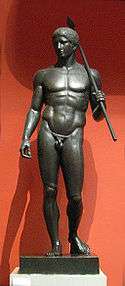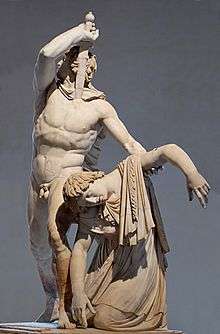Classical sculpture

Classical sculpture refers loosely to the forms of sculpture from Ancient Greece and Ancient Rome, as well as the Hellenized and Romanized civilizations under their rule or influence from about 500 BC to around 200 AD. More precisely it refers to Ancient Greek sculpture from around 500 BC to the onset of the Hellenistic style around 323 BC.[1] It may also refer stylistically to later sculpture done in a Neoclassical or classical style. Classical sculptures have been popular since the Renaissance. Only those works that closely follow the canon of classical forms would fall under the term.
In addition to free standing statues, the term classical sculpture incorporates relief work (such as the famous Elgin Marbles of the Parthenon) and the flatter bas-relief style. Whereas sculptural works emphasized the human form, reliefs were employed to create elaborate decorative scenes.
Ancient statues and bas-reliefs survive showing the bare surface of the material of which they are made, and people generally associate classical art with white marble sculpture. But there is evidence that many statues were painted in bright colours.[2] Most of the colour was weathered off over time; small remnants were removed during cleaning; in some cases small traces remained which could be identified.[2][3] A travelling exhibition of 20 coloured replicas of Greek and Roman works, alongside 35 original statues and reliefs, was held in Europe and the United States in 2008: Gods in Color: Painted Sculpture of Classical Antiquity.[4] Details such as whether the paint was applied in one or two coats, how finely the pigments were ground, or exactly which binding medium would have been used in each case—all elements that would affect the appearance of a finished piece—are not known.
There are several periods:
Archaic period
The most important sculptural form of the Archaic period was the kouros (plural: kouroi), the standing male nude (See for example Biton and Kleobis). Reflecting Egyptian influence, the kouros stands upright with his left leg slightly forward and his arms at his sides. Archaic Greek sculptors seem to have been influenced stylistically by the Egyptians, although divergences appeared early on. In particular, the male figures of Archaic Greece tended to be represented in the nude, while this was uncommon during all periods of ancient Egyptian art (except when slaves or enemies were depicted). As in Egyptian art, female subjects were always portrayed clothed; female nudity would not appear until much later on.
In this period, the later emphasis on naturalistic bone and muscle anatomy had not yet developed, which can be seen in observing details such as the knees and other critical joints. Some details seem to be "incised" rather than fully modeled, a relic of more ancient traditions. Nor did figures stand or move naturally. However, as the Archaic style gradually transformed into what is known as the Classical style, a clear progression displaying more and more technical knowledge and skill can be detected.
-

Unknown artist: Kouros Anavissos. National Archaeological Museum of Athens, ca. 530 BC
-

Unknown artist: Treasury of Siphnos frieze (detail), Delphi Archaeological Museum, ca. 525 BC
-

Attributed by some to Onatas or his school: Fallen Trojan warrior, figure W-VII of the west pediment of the Temple of Aphaia, Glyptothek, Munich, ca. 505–500 BC
-

Unknown artist: Funerary lion found at the Sacred Gate at the Kerameikon. Kerameikos Archaeological Museum, Athens, ca. 590–580 BC
Classical period
The Classical period saw changes in both the style and function of sculpture. Poses became more naturalistic (see the Charioteer of Delphi for an example of the transition to more naturalistic sculpture), and the technical skill of Greek sculptors in depicting the human form in a variety of poses greatly increased. From about 500 BC statues began to depict real people. The statues of Harmodius and Aristogeiton set up in Athens to mark the overthrow of the tyranny were said to be the first public monuments to actual people.
As Greek artists began to study human movement and anatomy, they discovered that living humans tend to display a "weight shift" or contraposition when standing.
The first Greek statue to exhibit contrapposto is the famed Kritios Boy, dating circa 480 BC. Contrapposto soon became a defining element of Greek sculptural technique, culminating in the Canon of the Doryphoros ("spear-bearer"), which adopted extremely dynamic and sophisticated contrapposto in its cross-balance of rigid and loose limbs.
Most of the sculptures made at this time were created to show appreciation to the gods for showing them good fortune, and also to help bring good fortune in the future, and to also gain favor from the gods. Greek temples were specially made to fit the large cult statues. They believed that placing shrines around the areas that were said to be holy would please the gods. Because Greek gods were mostly myths based on real people's lives mixed feelings were created about the sculptures, and therefore more man-like sculptures were created. Most sculptures created can be understood to represent myth, archetype or purpose in life.
During the classical period sculptors were not only creating works for temples, but also mortuary statues to show tribute to deceased loved ones. The sculptures would often show the deceased person in a relaxed pose. Successful athletes and rich families would commission statues of themselves for temples to show respect to the gods. In the 5th century BC portraits became popular and busts featuring generals, philosophers and political leaders appeared.
The high quality of Greek work attracted Italian interest, and greatly influenced both Etruscan, and later, Roman art. The enthusiasm with which Rome greeted Greek art has proven important not merely because of the transmission of classical Greek style, but also because most of the extant classical Greek works survive mainly in the form of Roman marble copies of Greek bronze originals. As bronze has always been a valuable metal, most of the originals were likely long ago melted down, and the few genuine survivals have been found mostly in the context of shipwrecks.
However, Greeks did carve marble, and a number of classical Greek marbles have survived; the famed Parthenon Marbles (also known as the Elgin Marbles), lasted in situ until the beginning of the 19th Century. In fact, many of the surviving classical Greek marbles are from an architectural context.
-

Polykleitos: Doryphoros. Cast in Pushkin Museum, Moscow.
-

Attributed to Euphranor: Paris or Perseus. Atikythera shipwreck, ca. 340–330 BC. National Archaeological Museum, Athens.
-

Phidias' workshop: Reclining Dionysos, from Parthenon east pediment, ca. 447–433 BC. British Museum
-

Aphrodite Braschi, free copy (1st century BC) after a votive statue of Praxitele in Cnidus (Aphrodite of Cnidus type, ca. 350–340 BC). Glyptothek, Munich
Hellenistic period
The transition from the Classical to the Hellenistic period occurred during the 4th century. Sculpture became more and more naturalistic. Common people, women, children, animals and domestic scenes became acceptable subjects for sculpture, which was commissioned by wealthy families for the adornment of their homes and gardens. Realistic portraits of men and women of all ages were produced, and sculptors no longer felt obliged to depict people as ideals of beauty or physical perfection. Most Greek men were sculpted standing with their hips slightly to the side. When human beings stand this way it uses more muscles.
-

Attributed by Pliny the Elder to Agesander, Athanodoros and Polydorus: Laocoön and His Sons. Copy after an Hellenistic original from ca. 200 BC. Vatican Museums
-

Unknown artist: Nike of Samothrace, c. 220-190 BC. Louvre
-

Unknown artist: Nereus, Doris, a giant, Oceanus, from the Pergamon Altar (detail), 2nd century BC. Pergamonmuseum, Berlin
-

Unknown artist: Ludovisi Gaul and his wife. Roman copy after an Hellenistic original from a monument built by Attalus I of Pergamon after his victory over Gauls, ca. 220 BC. Palazzo Altemps, Rome
Roman period

Roman sculpture began with the copying of Greek sculpture, but then evolved into a form of sculpture which more emphasised the individual. There are many surviving sculptures of Roman emperors.
Influence
Greco-Roman sculpture had a profound influence on Western art. With it, the Greco-Roman style established the possibility and potential of realism in art. Because of the relative durability of sculpture, it has managed to survive and continue to influence and inform artists in varying cultures and eras, from Europe to Asia, and today, the whole world.
While classical art gradually fell into disfavor in Europe after the fall of the Western Roman Empire, its rediscovery during the early Italian Renaissance proved decisive. One of the most important sculptors in the classical revival was Donatello. Many other sculptors such as Michelangelo also made works which can be considered classical. Modern Classicism contrasted in many ways with the classical sculpture of the 19th Century which was characterized by commitments to naturalism (Antoine-Louis Barye) -- the melodramatic (François Rude) sentimentality (Jean-Baptiste Carpeaux) -- or a kind of stately grandiosity (Lord Leighton) Several different directions in the classical tradition were taken as the century turned, but the study of the live model and the post-Renaissance tradition was still fundamental to them.
See also
References
- ↑ Cook, R.M., Greek Art, pp. 142, 148, Penguin, 1986 (reprint of 1972), ISBN 0140218661
- 1 2 Archeological Institute of America: Carved in Living Color
- ↑ io9.com: Ultraviolet light reveals how ancient Greek statues really looked
- ↑ Gods in Color: Painted Sculpture of Classical Antiquity September 22, 2007 Through January 20, 2008, The Arthur M. Sackler Museum